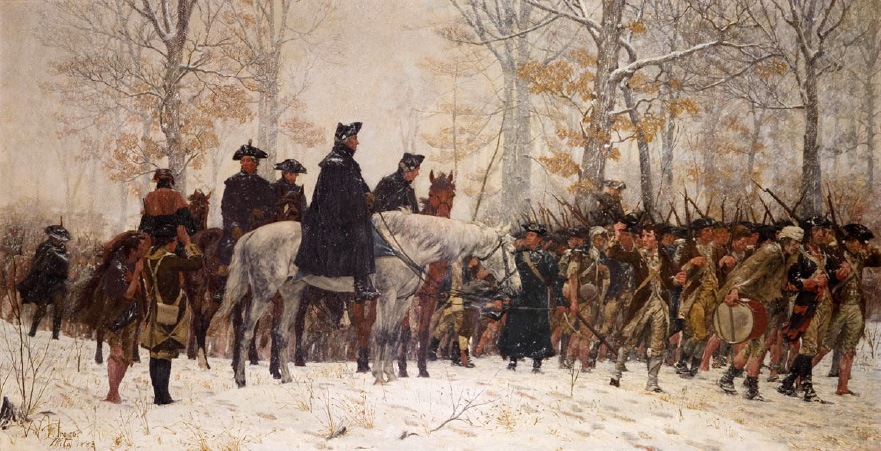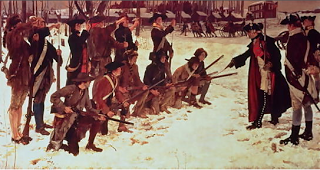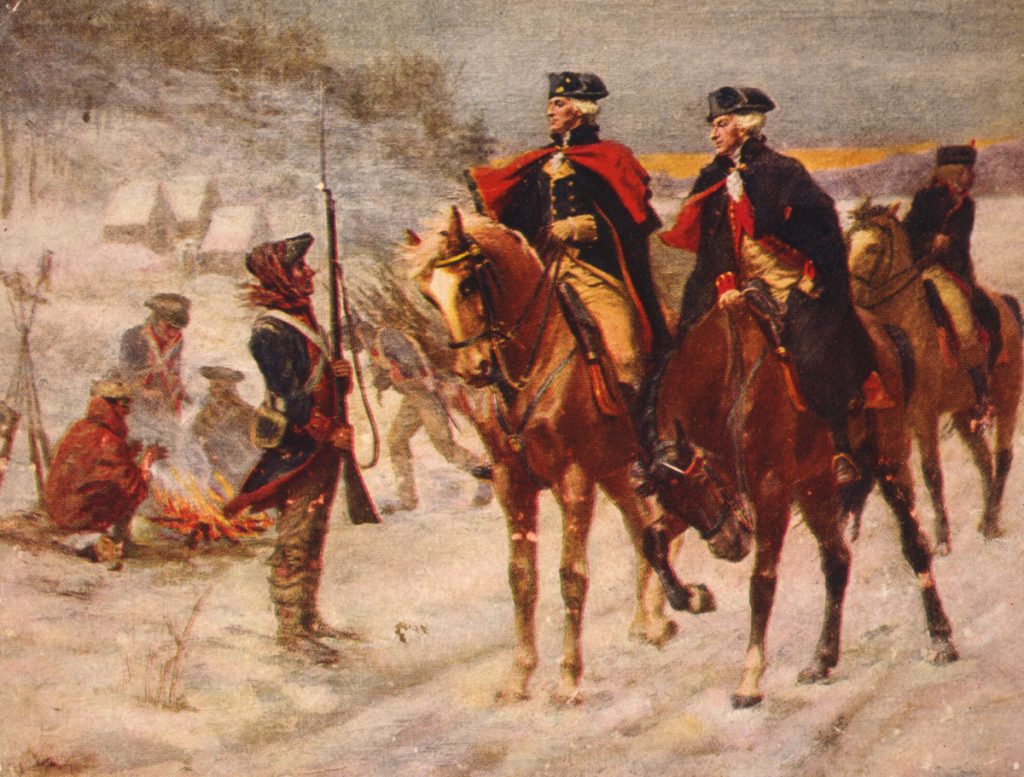Valley Forge is a well known topic of the American Revolutionary War. The Continental Army camped there from December 1777-June 1778. The conditions were harsh, and over 2,500 soldiers died from the cold, starvation, disease, exposure, and malnutrition. Women and children also accompanied their husbands and relatives while at Valley Forge as laundresses and nurses.
Tired from spending so much time marching, General George Washington and his 12,000 men stopped in Valley Forge, Pennsylvania on December 19, 1777. Many men had already fallen ill, they were poorly fed, and only one in three of them actually had shoes. They quickly began working on defense lines and selecting grounds for brigades to camp. Within three days, one hut made of logs and timber had been put up. By February, over 2,000 huts were built at Valley Forge. The hust were able to provide shelter for the men and their families, but they did not help much with the critical conditions at the camp. During the spring when it grew warmer, Washington made sure each hut also had two windows.
Soldiers were fed poorly, often eating “firecakes”, a mixture of flour and water, and small portions of meat and bread for some. On occasion they would have the opportunity to earn a black pepper flavored tripe broth called pepper pot soup. Because the Continental Army did not have a strong currency system, American Farmers often only accepted British money. Washington had even stated multiple times that winter that conditions were so harsh, that the army may have to disband because so many men were dying of starvation and the bad conditions. Sometimes, snow was melted into drinking water, but the layers of snow were usually too thin for this. Locals and fishermen recorded that when shad moved up the Schuylkill River in the spring, the troops were able to eat better than before. The Chief of Artillery, General Henry Knox, recorded that nearly 700 of their horses were dead by the end of the winter, dying from exhaustion or starvation.
Many men also died from exposure because their clothing was inadequate and shoes were destroyed from previous battles and spending so much time marching. It was hard to come by new clothes and blankets as well. Typhoid, typhus, smallpox, dysentery, and pneumonia were also running through the camp and killing many of the men, and it did not help they were cramped into small huts. By June when the troops finally moved out of Valley Forge, over 2,500 men died of malnutrition, exposure, and disease. Gouverneur Morris once stated that during the time at Valley Forge, the army was a “skeleton of an army…in a naked, starving condition, out of health, out of spirits.” Many soldiers deserted due to the poor conditions as well. The women and children would encourage them to not desert and would act as nurses and do the laundry.
Despite constant petitioning from Washington, the Continental Congress was unable to provide the army with more supplies and other needs, causing the soldiers to suffer even more so. After a month of being there, five men from Congress greeted Washington and inspected the camp. He informed them of the harsh conditions and asked that Congress pay for supplies and make sure the army always has what’s needed when supplies are scarce. Congress, by the end of February, had made sure that the army in Valley Forge was supplied and would continue to supply soldiers when needed.
Baron Friedrich von Steuben, a Military Officer from Prussia, began training and drilling the soldiers tirelessly. Prior to this, the army had not been properly trained, and they realized they needed to do so if they were going to win the war. He was able to teach the men how to accurately aim muskets, charge with bayonets, and maneuver together when in compact ranks. Von Steuben did not speak English well, and had to have translators with him and to help him translate the manual he wrote in French. He worked the men from dawn to dusk, training them hard so they were as prepared as possible.
On February 10, 1778, Washington’s beloved wife, Martha Washington, arrived after a ten day journey. She quickly organized a sewing circle with other women and together they knitted and patched up socks, shirts, and trousers. Martha would visit soldiers in their huts and in the hospitals, though it is noted that she rarely socialized or visited with the common soldiers because of her high status and wealth. Many other soldiers had their wives, children, mothers, sisters, or other female relatives join them at camp. The women would do laundry, clean and mend uniforms, and tend to soldiers. When conditions and the weather were rough, the women and children were always there to encourage the men to continue training and to not leave the army. If they had done enough work for the soldiers by the end of the war, the women were also given half the wages and pension as the soldiers. Women were given a half of the rations as men, and it is said that the children were given a quarter, though there is no record of this. Some would even scout for the army or go collect supplies and food. Many women died from disease, retrieving supplies from dead soldiers, and the cold. Overall there were an estimated 500 women, with one to every forty-four soldiers.
Many people, Congressmen included, began to publicly criticise Washington while the army was stationed at Valley Forge because he had not made any efforts on the British army. However, they did find out that France was going to begin aiding the army formally after the winter because of the previous victories during the Battle of Saratoga. On February 6, 1778 France and the colonies signed an alliance pact. The soldiers at Valley Forge celebrated the new alliance on May 6, 1778. Thousands of men performed drill formations and fired from their muskets and cannons as salutes. Each soldier was then given a gill of rum after the celebrations. Exactly six months after the army’s arrival at Valley Forge on December 19, 1777, they packed up and marched out on June 19, 1778.




